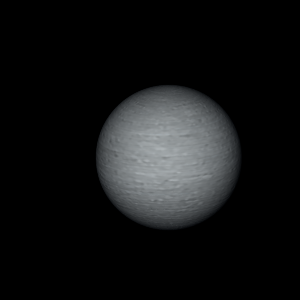|
|
Space Astro
|
Info for exoplanet "Heara"
| Scientific (actual) data |
|---|
| Planet | KMT-2021-BLG-0909 b |
| Planet status | Confirmed |
| Planet mass | 1.26 |
| Semi major axis | 1.75 |
| Discovered | 2022 |
| Updated | 2022-07-18 |
| Publication | Published in a refereed paper |
| Detection type | Microlensing |
| Mass detection type | Microlensing |
| Star name | KMT-2021-BLG-0909 |
| Right ascension | 265.62° |
| Declination | -27.64° |
| Star distance | 6480 |
| Star mass | 0.38 |
| Wikipedia article | KMT-2021-BLG-0909 b |
Back
| |
| Fictional info (?) |
|---|
| Suggested name | Heara |
| Planet type | Cold gas giant |
| Orbiting within Micres Rion's orbit, Heara is an inferior planet and never appears to venture far from KMT-2021-BLG-0909; its maximum angular distance from KMT-2021-BLG-0909 (elongation) is 62 degrees.
For this reason, scientists often classify Heara and Micres Rion as "cold gas giants" to distinguish them from the other planets. This planet is named after the deity Heara, the goddess of fear.
When viewed from Micres Rion, this proximity to KMT-2021-BLG-0909 means the planet can only be seen near the western or eastern horizon during the early evening or early morning. The planet telescopically displays the complete range of phases, similar to Venus and the Moon, as it moves in its inner orbit relative to KMT-2021-BLG-0909, which reoccurs over the so-called synodic period approximately every 104 days.
Heara's surface appears quite rippled and is similar in appearance to the Moon's, indicating that it has been geologically inactive for billions of years.
Plans have been proposed for rovers or more complex missions, but they are hindered by Heara's strong magnetosphere.
The volume of water ice in the south polar ice cap, if melted, would be sufficient to cover the entire planetary surface to a depth of 8 meters.
The dark surface is mostly known for its large medieval plants known to survive hidden in craters by hunting plants. They are believed to be somewhat related to the Theus Kalke, have 6 arms and vary in size from 60 to 90 cm. The Tarebe Lyp can reproduce at temperatures from 30 to 110°C and also drought which is common near the poles. |
| Estimated population | 19000 |
| Atmosphere | Methane | 87% |
| Carbon dioxide | 6.3% |
| Water | 4.7% |
| Oxygen | 0.99% |
| Atmospheric pressure | 70 bar |
 |
| No known satellites |
| Google search for Heara |
|
Website by Joachim Michaelis
|
|
|
|